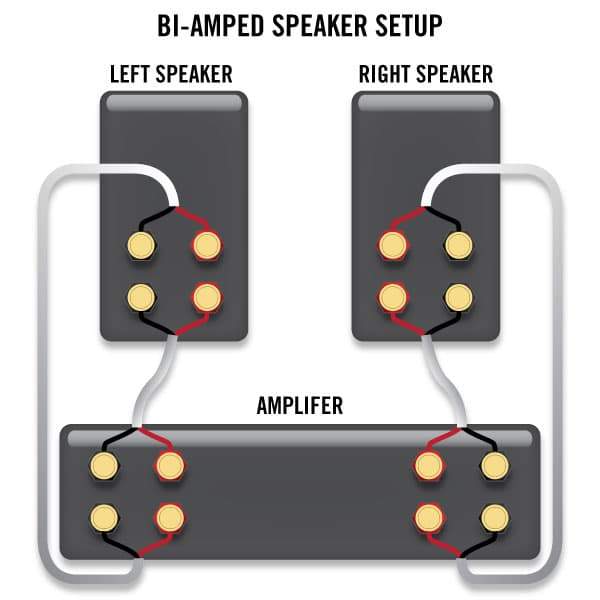
How to Bi-Wire and Bi-Amp Your Speakers
Find out if it's worth it to Bi-Wire or Bi-Amp your speakers and how to do it
Jared Norman | Jun 27, 2013
Audiophiles are always looking for new ways to get the most out of their audio equipment. Over the years people have found creative ways for enhancing sound quality beyond just buying more expensive speakers. There are two techniques in particular that we will talk about here: Bi-Wiring and Bi-Amping. While neither of these techniques are strictly necessary, they can potentially give you better sound.
Speakers are usually a combination of two specific speakers: high frequency speakers (or tweeters) and low frequency (or bass) speakers. Both Bi-Wiring and Bi-Amping try to improve sound quality by isolating these components from one another.
Bi-Wiring
Bi-wiring is a way of connecting a speaker to an audio amplifier. Normally only one cable connects the speaker to the amplifier. In bi-wiring, each loudspeaker uses two cables (one for the tweeter and one for the bass in the speaker) which are then connected to the same amplifier. Since both sets of cables connect to the same ports on the amplifier, many people argue that there is no benefit to this kind of setup and that it is a waste of money. However, many audio enthusiasts feel that bi-wiring good speakers can make a subtle improvement to middle range sound. Mid-range is arguably the most important part of the music; for one thing, the human voice falls into this range. According to these audio enthusiasts, voices are clearer and less muffled by using bi-wiring.
How to Bi-Wire
Most modern speakers come with two pairs of binding posts: one pair for the high frequency and one for the low frequency. These speakers come with a conductive bar that links the two posts together so you only need one cable to connect the speakers to your amplifier.

To bi-wire your speakers, you first need to remove these linking bars. You then connect wires for each of the terminals and connect them to the amplifier. That means that there will be two sets of cables running to each of the connections of the amplifier. Another option you have is to use four conductor speaker cable.

If you are using banana plugs, make sure you get the kind that will allow you to attach a wire from the side and another banana plug in the back, otherwise you won't be able to connect all your cables to your amplifier. While some claim that banana plugs nave a negative effect on the sound, most agree that banan plugs give a you a better connection and improve the sound because of it. Learn more about how to use banana plugs with speaker wire.
Bi-Amping
Bi-Amping further isolates the different frequency signals by giving the high frequency and the low frequency speakers their own amplification channel. Some multi-channel receivers allow you to use four of the available amplification channels to independently power the upper and lower sets of binding posts.
Some audio enthusiasts feel that bi-amping improves the sound during more demanding moments of music or movies. Essentially it is like having four-wheel-drive when going off road; on rough, rocky terrain it is often better to send power directly to each of the wheels. In your sound system, when the sound is more demanding, sending power to each specific speaker can produce sound that feels less constrained.
Another benefit to this setup is that it gives you the option of buying multiple amplifiers to power your speakers. That way you could look for amplifiers based on sound quality, without having to worry so much about the amount of power the amplifier can produce.
How to Bi-Amplify
The process of bi-amplifying your speaker setup is almost identical to that of bi-wiring. The only difference is that after you have two sets of cable coming from each speaker, you attach each of these sets of cable to its own set of binding post on the amplifier (or to different amplifiers if you want).

Conclusion
The differences offered by these solutions may seem minimal to many listeners, but true audio enthusiasts could find one of these techniques well worth the extra effort. However, whether you decide to bi-amplify, bi-wire, or keep your speakers the way they are it is important to find the right speaker cable for your speaker setup. That includes finding cable with high quality conductors, which almost always means getting pure copper wire conductors (copper wire is the standard for conductive materials). It also means finding the correct gauge wire for your speakers. Find out more about wire gauge (AWG).
Here at Sewell we have a wide range of speaker cables of all lengths and gauges. From our 16 gauge pure copper cable, to our premium 12 gauge Silverback speaker cable, you are ensured to find the best cable for your speaker setup.
